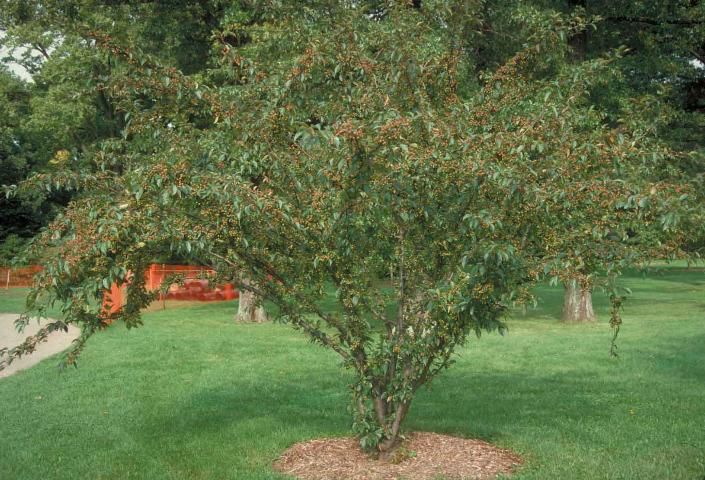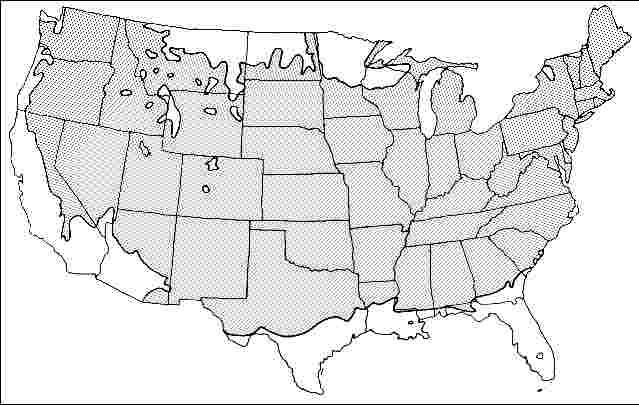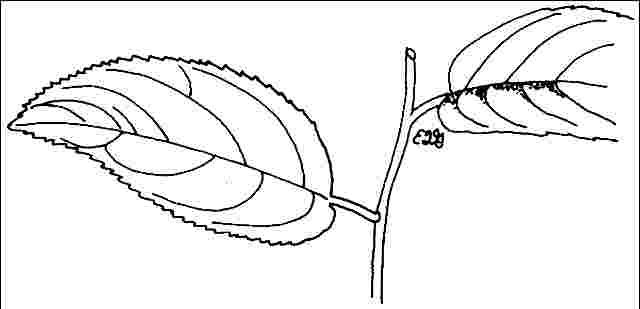Introduction
Flowering tea crabapple is composed of strong, spreading branches that form a broad, vase-shaped silhouette, 15 to 20 feet tall and 20 feet wide. The main branches are usually trained to grow from one point on the trunk and these grow long and branch infrequently, forming an open canopy that allows light to easily pass. Abundant fragrant, light pink to white blooms appear in springtime, each 1.5-inch-diameter blossom starting out as a tight, deep pink bud. The small, .5-inch fruits which follow are outstanding, their greenish-yellow faces endowed with blushing red cheeks. Fruit is very attractive to birds. The dark grey/brown, flaking bark is quite attractive and is shown off to its best advantage when the trees are grown in containers or as an espalier.

Credit: Ed Gilman, UF/IFAS
General Information
Scientific name: Malus hupehensis
Pronunciation: MAY-lus hew-peh-EN-sis
Common name(s): Tea crabapple, flowering tea crabapple
Family: Rosaceae
USDA hardiness zones: 4A through 8A (Fig. 2)
Origin: not native to North America
Invasive potential: little invasive potential
Uses: sidewalk cutout (tree pit); container or planter; espalier; specimen; parking lot island < 100 sq ft; parking lot island 100-200 sq ft; parking lot island > 200 sq ft; tree lawn 3-4 feet wide; tree lawn 4-6 feet wide; tree lawn > 6 ft wide; street without sidewalk; highway median; bonsai
Availability: somewhat available, may have to go out of the region to find the tree

Description
Height: 15 to 20 feet
Spread: 15 to 20 feet
Crown uniformity: symmetrical
Crown shape: vase, spreading
Crown density: open
Growth rate: moderate
Texture: medium
Foliage
Leaf arrangement: alternate (Fig. 3)
Leaf type: simple
Leaf margin: serrate
Leaf shape: obovate, elliptic (oval)
Leaf venation: pinnate, brachidodrome
Leaf type and persistence: deciduous
Leaf blade length: 2 to 4 inches
Leaf color: green
Fall color: yellow
Fall characteristic: not showy

Flower
Flower color: pink, white/cream/gray
Flower characteristics: very showy
Fruit
Fruit shape: round
Fruit length: less than .5 inch
Fruit covering: fleshy
Fruit color: yellow, red
Fruit characteristics: attracts birds; showy; fruit/leaves not a litter problem
Trunk and Branches
Trunk/bark/branches: branches droop; showy; typically multi-trunked; thorns
Pruning requirement: little required
Breakage: resistant
Current year twig color: brown
Current year twig thickness: medium
Wood specific gravity: unknown
Culture
Light requirement: full sun
Soil tolerances: clay; sand; loam; acidic; alkaline; well-drained; occasionally wet
Drought tolerance: moderate
Aerosol salt tolerance: low
Other
Roots: not a problem
Winter interest: yes
Outstanding tree: yes
Ozone sensitivity: sensitive
Verticillium wilt susceptibility: resistant
Pest resistance: resistant to pests/diseases
Use and Management
Crabapples are also useful as median trees where the fruit will fall away from pedestrians. Placed in the lawn area as an accent so they receive occasional irrigation, crabapple will give you years of wonderful flowers and showy fruit. It is best to locate them away from a patio or other hard surface so the fruits will not fall and cause a mess. Set it back just far enough so the crown will not overhang the walk, but close enough so the flowers and fruit can be enjoyed.
Some training and pruning is required to develop good branch structure. Pruning should be completed before late spring, to ensure dormant flower buds are not removed. Unpruned, open-grown trees branch low and these branches droop to touch the ground. The spreading canopy makes this tree best suited for specimen use. It should be occasionally thinned to eliminate water sprouts or crossed-branches. This allows for better air circulation through the crown and helps reduce disease.
Flowering tea crabapple grows in moist, well-drained, acid soil in full sun locations for best flowering. They are not recommended for sandy soil due to their inability to tolerate extended drought, but any other soil is suitable, including well-drained clay. Not city tolerant. Crabapples grow well in the Texas panhandle but are not extremely drought tolerant and are not well suited for high pH soil.
Contact the Ornamental Crabapple Society, Morton Arboretum, Lisle, Illinois 60532 for more information on crabapples.
Propagated by seed.
Pests
Aphids infest branch tips and suck plant juices.
Fall webworm makes nests on the branches and feeds inside the nest. Small nests can be pruned out or sprayed with Bacillus thuringiensis.
Scales of various types are usually controlled with horticultural oil.
Mites are too small to see easily so can cause much foliage discoloration before being detected. Mites are usually controlled with horticultural oil.
Tent caterpillar builds tents or nests in trees in early summer or late spring. Feeding occurs outside the nest. Small nests are pruned out or simply pulled from the tree and caterpillars crushed. Do not burn nests while they are still in the tree since this injures the tree and could start an uncontrolled fire.
Diseases
There is some susceptibility to fire blight.
Scab infection takes place early in the season and dark olive green spots appear on the leaves. In late summer the infected leaves fall off when they turn yellow with black, spots. Infected fruits have black, slightly raised spots.
Fire blight susceptible trees have blighted branch tips. Leaves on infected branch tips turn brown or black, droop, and hang on the branches. The leaves look scorched as by a fire. The trunk and main branches become infected when the bacteria are washed down the branches. Cankers form and are separated from adjacent healthy bark by a crack. The infected bark may be shredded.
Powdery mildew is a fungus which coats leaves with mycelia resembling white powder.
Rust causes brown to rusty-orange spots on the leaves. Badly spotted leaves fall prematurely. Redcedars are the alternate host.
Crabapples are subject to several canker diseases. Prune out infected branches, avoid unnecessary wounding, and keep trees healthy.
